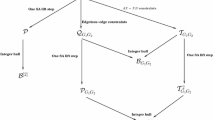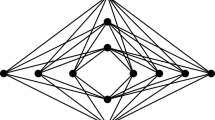Abstract
Aurora and Mehta (J Comb Optim 36(3):965–1006, 2018) show that two graphs \(G_1,G_2\), on n vertices each, are isomorphic if and only if the feasible region of a certain linear program, LP-GI, intersects with the Quadratic Assignment Problem (QAP)-polytope in \({\mathbb {R}}^{(n^4+n^2)/2}\). The linear program LP-GI in Aurora and Mehta (J Comb Optim 36(3):965–1006, 2018) is obtained by relaxing an integer linear program whose feasible points correspond to the isomorphisms between \(G_1,G_2\). In this paper we take an analogous approach with the linear programs replaced with conic programs. A completely positive description of the QAP-polytope was obtained in Povh and Rendl (Discrete Optim 6(3):231–241, 2009). By adding the graph conditions to this description we get a completely positive formulation of the graph isomorphism problem. However, analogous to integer linear programs, it is NP-hard to optimize over the cone of completely positive matrices. So we relax this formulation by replacing the cone of completely positive matrices with the cone of positive semidefinite matrices. We observe that the resulting SDP is the Lovász Theta function (Lovász in IEEE Trans Inf Theory 25(1):1–7, 1979) of a graph product of \(G_1,G_2\) and can be efficiently computed. We provide a natural heuristic that uses the SDP to solve the graph isomorphism problem. We run our heuristic on several pairs of non-isomorphic strongly regular graphs and find the results to be encouraging. Further, by adding the non-negativity constraints to the SDP, we obtain a doubly non-negative formulation, DNN-GI. We show that if the set of optimal points in DNN-GI contains a point of rank at most 3, then the given pair of graphs must be isomorphic.
Similar content being viewed by others
References
Aurora P, Mehta SK (2018) The qap-polytope and the graph isomorphism problem. J Comb Optim 36(3):965–1006
Babai L (2016) Graph isomorphism in quasipolynomial time [extended abstract]. In: Proceedings of the 48th annual ACM SIGACT symposium on theory of computing, STOC 2016, Cambridge, MA, USA, June 18–21, pp 684–697
Cai J, Fürer M, Immerman N (1992) An optimal lower bound on the number of variables for graph identifications. Combinatorica 12(4):389–410
Chen J, Kanj IA, Perkovic L, Sedgwick E, Xia G (2007) Genus characterizes the complexity of certain graph problems: Some tight results. J Comput Syst Sci 73(6):892–907
de Klerk E, Pasechnik DV (2002) Approximation of the stability number of a graph via copositive programming. SIAM J Optim 12(4):875–892
Grötschel M, Lovász L, Schrijver A (1988) Geometric algorithms and combinatorial optimization. In: Cook WJ, Graham RL, Korte B, Lovász L, Wigderson A, Ziegler GM (eds) Algorithms and combinatorics, vol 2. Springer, Berlin. https://doi.org/10.1007/978-3-642-97881-4
Karp RM (1972) Reducibility among combinatorial problems. In: Proceedings of a symposium on the complexity of computer computations, held March 20–22, 1972, at the IBM Thomas J. Watson Research Center, Yorktown Heights, New York, pp 85–103
Kozen D (1978) A clique problem equivalent to graph isomorphism. SIGACT News 10(2):50–52
Lasserre JB (2001) Global optimization with polynomials and the problem of moments. SIAM J. Optim 11(3):796–817
Lovász L (1979) On the shannon capacity of a graph. IEEE Trans Inf Theory 25(1):1–7
Malkin PN (2014) Sherali-adams relaxations of graph isomorphism polytopes. Discrete Optim 12:73–97
O’Donnell R, Wright J, Wu C, Zhou Y (2014) Hardness of robust graph isomorphism, lasserre gaps, and asymmetry of random graphs. In: Proceedings of the twenty-fifth annual ACM-SIAM symposium on discrete algorithms, SODA 2014, Portland, Oregon, USA, January 5–7, 2014, pp 1659–1677
Povh J, Rendl F (2009) Copositive and semidefinite relaxations of the quadratic assignment problem. Discrete Optim 6(3):231–241
Santis MD, Rendl F, Wiegele A (2017) Dadal—using a factored dual in augmented lagrangian methods for semidefinite programming. https://www.math.aau.at/or/Software/. Accessed 20 May 2020
Santis MD, Rendl F, Wiegele A (2018) Using a factored dual in augmented lagrangian methods for semidefinite programming. Oper Res Lett 46(5):523–528
Snook A, Schoenebeck G, Codenotti P (2014) Graph isomorphism and the lasserre hierarchy. CoRR. arXiv:1401.0758
Spence E. Strongly regular graphs. http://www.maths.gla.ac.uk/es/srgraphs.php. Accessed 17 Apr 2019
Author information
Authors and Affiliations
Corresponding author
Additional information
Publisher's Note
Springer Nature remains neutral with regard to jurisdictional claims in published maps and institutional affiliations.
Rights and permissions
About this article
Cite this article
Aurora, P., Mehta, S.K. A completely positive formulation of the graph isomorphism problem and its positive semidefinite relaxation. J Comb Optim 40, 590–609 (2020). https://doi.org/10.1007/s10878-020-00598-w
Published:
Issue Date:
DOI: https://doi.org/10.1007/s10878-020-00598-w




